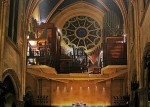Title
Just a mile down Broadway from Juilliard, the Church of St. Mary the Virgin, near Times Square, boasts one of the finest pipe organs in New York. On January 22, its Gothic arches will echo with the sounds of a recital by the eight students of the Juilliard organ department.
The recital takes place at the Church of Saint Mary the Virgin, 145 W. 46 St. between Sixth and Seventh Aves.
Body
The organ of St. Mary’s was built in 1932 by the Aeolian-Skinner Company of Boston, and later added to in several stages. It was designed for versatility, combining the clear, bright sounds necessary for Baroque music with sumptuous colors for the Romantic literature and a battery of powerful trumpets to cap off the ensemble. The result is an instrument that can render the entire organ literature in its own unique voice.
Every organ is custom-built and voiced by hand for its acoustical environment; in choosing repertoire for a concert, it is essential to consider the strengths of the instrument at hand. And once the repertoire is selected, the organist must quickly adapt to the peculiarities of the instrument in choosing which sets of pipes, or stops, to use. Tempos, dynamics, and articulation must all be adjusted to suit the venue; what works in an intimate recital hall may not succeed in a resonant church. In preparation for a recital like this, each student must spend several hours at the console, trying different combinations of sounds and deciding how to manipulate them.
Fourth-year Gregory Zelek will play the Toccata and Fugue, Nos. 5 and 6 from Max Reger’s 12 Organ Pieces, Op. 59, which explore the extremes of the organ’s dynamic range, from whisper-quiet to thunderously loud. Third-year Colin MacKnight’s selections will contrast the virtuosic polytonal outbursts of Fête by Jean Langlais with the lush orchestral textures of the Andante espressivo from Edward Elgar’s Organ Sonata, Op. 28. Fourth-year David Ball will perform the bubbly Fantasie in E-Flat by Camille Saint-Saëns. Closer to home is the music of Calvin Hampton, who was organist of Calvary Episcopal Church in New York from 1963 to 1983. In honor of the 30th anniversary of his death, third-year Griffin McMahon has chosen to program three of his Five Dances for Organ.
Original transcriptions will also feature prominently. Second-year master’s student Michael Hey will perform his own arrangement of two preludes and fugues from Dmitri Shostakovich’s Op. 87: F-sharp Major and D-flat Major. I will play my transcription of six pieces from Sergei Prokofiev’s Music for Children, Op. 65. Although neither Prokofiev nor Shostakovich wrote for the organ, these piano compositions sound perfectly idiomatic in transcription and offer a chance to hear familiar music in a fresh context.
Completing the program are two contrasting pieces based on German chorale melodies. Felix Mendelssohn’s Sonata No. 6 in D minor opens with a dark and powerful set of variations on the Lord’s Prayer, Vater unser im Himmelreich. Third-year Janet Yieh will perform the complete sonata, which moves from turbulence to serenity in the delicate final movement. B.C.J.E. student Ryan Kennedy will play Hugo Distler’s Partita on Wachet auf, Op. 8, No. 2. Like the St. Mary’s organ which predates it by six years, Distler’s 1938 partita straddles the boundaries of the late Romantic and Neo-Classical, maintaining contact with both styles.
While department chair Paul Jacobs won’t be performing in the January concert, he’s no stranger to the St. Mary’s organ—he made his Grammy-winning recording of Messiaen’s Livre du Saint-Sacrement on it. “For the organist, the thrill of playing this great instrument is akin to conducting a first-class orchestra,” he told The Journal. “For the listener, hearing organ music in this mystical space provides an experience like no other.”





